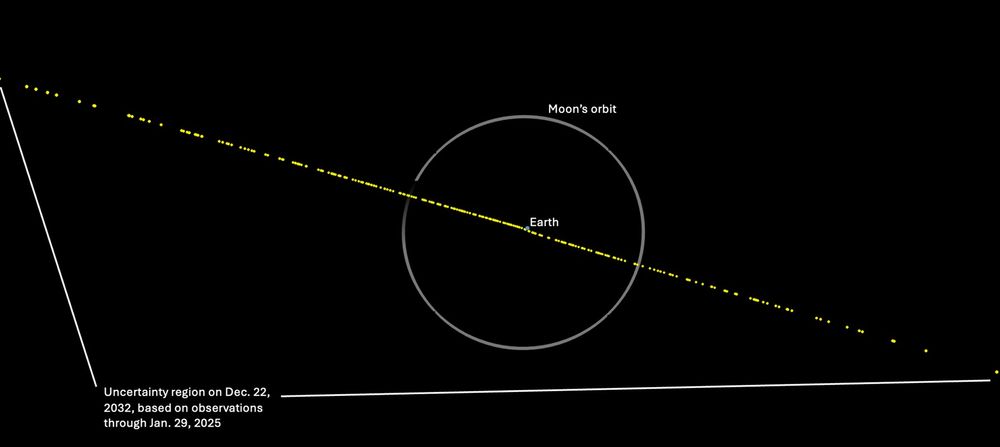Astronomers discover 196-foot asteroid with 1-in-83 chance of hitting Earth in 2032
A newly discovered asteroid, designated 2024 YR4, has a 1-in-83 chance of impacting Earth in eight years from now - on 22 December 2032. Estimated to be 196 feet (60 meters) wide, it is currently 27 million miles (over 35.4 million kilometers) away.
The asteroid is classified as a Level 3 threat on the Torino Impact Scale, indicating a close approach that warrants monitoring. If it misses, it is expected to pass within 66,000 miles (106,200 km) of Earth, according to NASA’s Center for Near-Earth Object Studies (CNEOS).
More to read:
[videos] Asteroid Bennu has a slim chance to hit Earth in September 2182
However, uncertainties in its orbit mean a direct impact remains a possibility.
Tracking the threat
2024 YR4 has now topped the European Space Agency’s NEO Impact Risk List and NASA’s Sentry Risk Table.

The diagram showing a line of uncertainty for a 1.3% chance of collision with Earth. Credit: David Rankin
“Odds have slightly increased to 1 in 83,” Catalina Sky Survey engineer David Rankin wrote in a BlueSky post.
“This is one of the highest impact probabilities for a significantly sized asteroid ever recorded.”
The asteroid was initially discovered by NASA’s ATLAS project using a telescope in Rio Hurtado, Chile. Rankin later confirmed it using data from the Catalina Sky Survey.
While the risk corridor currently stretches from South America across the Atlantic to sub-Saharan Africa, Rankin urges caution in interpreting early predictions.

The potential area for 2024 YR4's impact. Credit: Robert Lea
“Its orbit remains too uncertain to determine if it will hit, and the most likely outcome is still a miss,” he said in a statement for Space.com. “New observations will refine our calculations.”
Potential impact scenarios
If 2024 YR4 does collide with Earth, the consequences depend on its composition. A stony asteroid could cause a significant atmospheric explosion, or “airburst,” similar to the 1908 Tunguska event, which flattened 830 square miles (2,150 sq.km.) of Siberian forest. An iron asteroid, however, would likely survive atmospheric entry and create an impact crater.
More to read:
Asteroid 33 Polyhymnia likely contains elements outside periodic table
Currently, astronomers estimate the asteroid's size based on its brightness, but its actual dimensions depend on surface reflectivity. Radar observations - currently unavailable - would provide a more accurate measurement.
2024 YR4 will make a much closer but less risky pass in 2028, coming within 5 million miles (8 million kilometers) of Earth. This will provide a critical opportunity for astronomers to refine its orbit, size, and composition.
Astronomers will continue tracking it with 8-meter-class telescopes through February in attempt to learn for sure if it will hit or miss in 2032. By 2028, they should have a clearer answer.
For now, while astronomers remain vigilant, there is no immediate cause for alarm.
***
NewsCafe is an independent outlet. Our sources of income amount to ads and subscriptions. You can support us via PayPal: office[at]rudeana.com or https://paypal.me/newscafeeu, or https://buymeacoffee.com/newscafe - any amount is welcome. You may also want to like or share our story, that would help us too.






